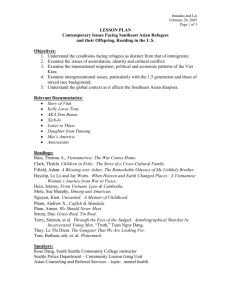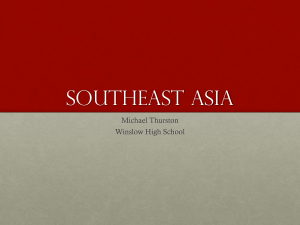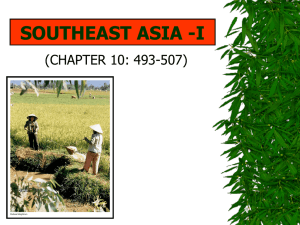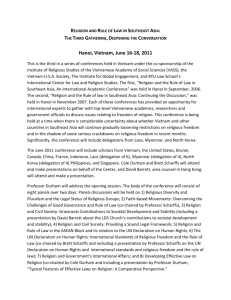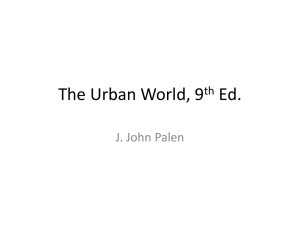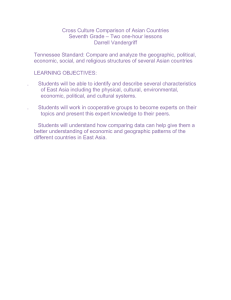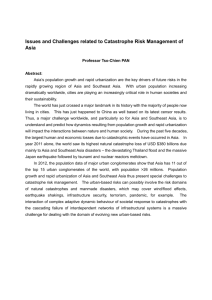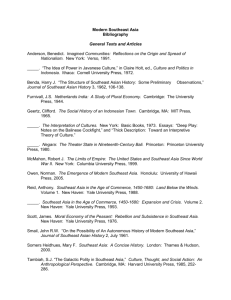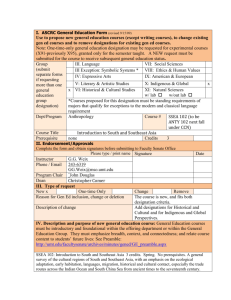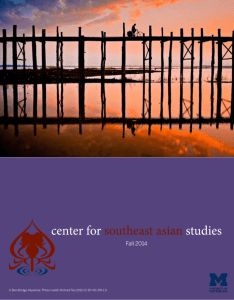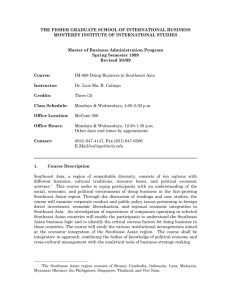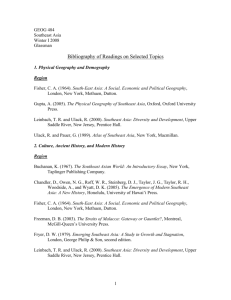Weekly Discussion and Discussion Presentations 2011
advertisement
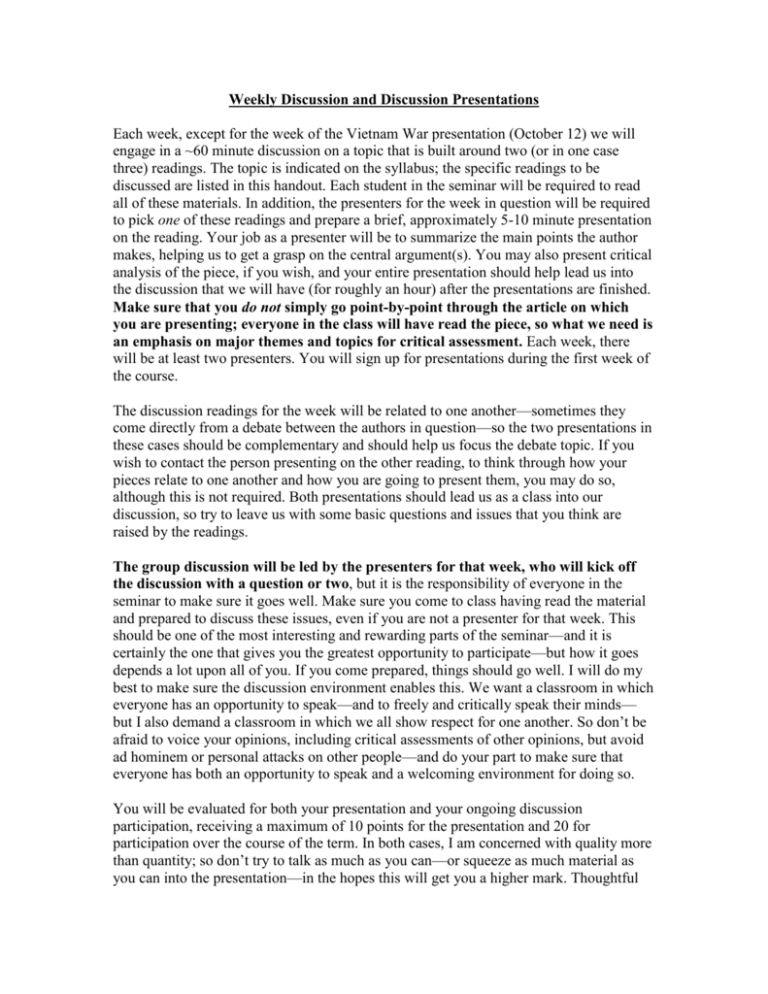
Weekly Discussion and Discussion Presentations Each week, except for the week of the Vietnam War presentation (October 12) we will engage in a ~60 minute discussion on a topic that is built around two (or in one case three) readings. The topic is indicated on the syllabus; the specific readings to be discussed are listed in this handout. Each student in the seminar will be required to read all of these materials. In addition, the presenters for the week in question will be required to pick one of these readings and prepare a brief, approximately 5-10 minute presentation on the reading. Your job as a presenter will be to summarize the main points the author makes, helping us to get a grasp on the central argument(s). You may also present critical analysis of the piece, if you wish, and your entire presentation should help lead us into the discussion that we will have (for roughly an hour) after the presentations are finished. Make sure that you do not simply go point-by-point through the article on which you are presenting; everyone in the class will have read the piece, so what we need is an emphasis on major themes and topics for critical assessment. Each week, there will be at least two presenters. You will sign up for presentations during the first week of the course. The discussion readings for the week will be related to one another—sometimes they come directly from a debate between the authors in question—so the two presentations in these cases should be complementary and should help us focus the debate topic. If you wish to contact the person presenting on the other reading, to think through how your pieces relate to one another and how you are going to present them, you may do so, although this is not required. Both presentations should lead us as a class into our discussion, so try to leave us with some basic questions and issues that you think are raised by the readings. The group discussion will be led by the presenters for that week, who will kick off the discussion with a question or two, but it is the responsibility of everyone in the seminar to make sure it goes well. Make sure you come to class having read the material and prepared to discuss these issues, even if you are not a presenter for that week. This should be one of the most interesting and rewarding parts of the seminar—and it is certainly the one that gives you the greatest opportunity to participate—but how it goes depends a lot upon all of you. If you come prepared, things should go well. I will do my best to make sure the discussion environment enables this. We want a classroom in which everyone has an opportunity to speak—and to freely and critically speak their minds— but I also demand a classroom in which we all show respect for one another. So don’t be afraid to voice your opinions, including critical assessments of other opinions, but avoid ad hominem or personal attacks on other people—and do your part to make sure that everyone has both an opportunity to speak and a welcoming environment for doing so. You will be evaluated for both your presentation and your ongoing discussion participation, receiving a maximum of 10 points for the presentation and 20 for participation over the course of the term. In both cases, I am concerned with quality more than quantity; so don’t try to talk as much as you can—or squeeze as much material as you can into the presentation—in the hopes this will get you a higher mark. Thoughtful contributions and careful analysis are what will be valued the most. This doesn’t mean, though, that you should not speak until you are absolutely sure you’ve got it right. Thoughtfulness means having made the effort to think things through, not the quest for absolute certainty! The marking for this part of the course will be based on the same percentages as the rest of the marking, as indicated on the syllabus. That is, an ‘A’ presentation or an ‘A’ level of discussion participation will be worth 80 percent of the points or more, and so on. Generally, you can expect that if you do a decent job of presenting or participating you will be somewhere in the ‘B’ range. If you clearly make a superior effort, and/or provide some unusually keen insights, this will pull you up to the ‘A’ level. While attendance is not a general requirement for the seminar, it is of course a requirement for participating. No one can avoid being sick or having emergencies arise that prevent attendance, but if you have missed more than 2 classes without it being attributable to unusually bad luck you may expect that this will pull down your participation mark. If you are going to miss more than 3-4 classes, you had best speak with me about this, since it will be likely to pull down your participation mark fairly severely. If you are having trouble in preparing the presentation, don’t hesitate to talk with me about this. It is not meant to be a daunting or extremely time-consuming task, so if you find yourself puzzling over it a lot, or worrying about what to say, you may be “overanalyzing” your task. Ask me, and maybe I can help. Discussion Presentations Readings, by Week * - Indicates recommended reading, not part of presentations. Please read these pieces if you would like but do not choose them for your presentations. They may be addressed in your term paper if you choose to use them for this purpose. Week 1 (September 7) Discussion topic: How did Southeast Asia come into being? *Benedict Anderson, The Spectre of Comparisons: Nationalism, Southeast Asia, and the World (London and New York: Verso, 1998): 1-17. *Anthony Reid, Charting the Shape of Early Southeast Asia (Chiang Mai: Silkworm Books, 1999): 1-14. Week 2 (September 14) Discussion topic: Were women in ancient Southeast Asia empowered? Reid, A. (1988). “Female roles in pre-colonial Southeast Asia.” Modern Asian Studies 22: 629-645. Errington, S. (1990). “Recasting Sex, Gender and Power: A Theoretical and Regional Overview,” in S. Errington, ed., Power and Difference: Gender in Island Southeast Asia (Stanford: Stanford University Press): 1-58. Week 3 (September 21) Discussion topic: Were pre-colonial Southeast Asian economies self-sufficient? Chatthip Nartsupha. (1984/1999). The Thai Village Economy in the Past (Chiang Mai: Silkworm): 60-72. Bowie, K. (1992). “Unraveling the Myth of the Subsistence Economy: Textile Production in Nineteenth-Century Northern Thailand,” Journal of Asian Studies 51, 4: 797823. *Chatthip Nartsupha and Suthy Prasartset. (1981). The Political Economy of Siam, 18511910 (Bangkok: Social Science Association of Thailand): 1-41. *Dixon, C. (1991). Southeast Asia in the World-Economy: A Regional Geography (Cambridge: Cambridge University Press): 35-56. Week 4 (September 28) Discussion topic: Were colonial peasants safety-oriented or entrepreneurial? What made them rebel against French colonialism? Popkin, S. (1979). The Rational Peasant: the Political Economy of Rural Society in Vietnam. (Berkeley: University of California Press): 1-31. Scott, J. C. (1976). The moral economy of the peasant: rebellion and subsistence in Southeast Asia. (New Haven; London, Yale University Press): 1-34. *Paige, J. M. (1975). Agrarian Revolution: Social Movements and Export Agriculture in the Underdeveloped World (New York and London: Free Press): 278-333. *Long, N.-V. (1991). Before the Revolution: The Vietnamese Economy Under the French (New York: Columbia University Press): 3-41. Week 5 (October 5) Discussion topic: What was the relationship between Communism, Nationalism, and class struggle in the Vietnamese revolution? Neal, J. (2003). A People’s History of the Vietnam War (New York and London: The New Press): 8-42. Bello, W. (2007). Walden Bello Presents Ho Chi Minh, Down With Colonialism (London and New York: Verso): ix-xliv. *Chandler, D. et al. (2005). The Emergence of Modern Southeast Asia: A New History (Honolulu: University of Hawai’i Press, 2005): 335-349. *Ho Chi Minh (1973). “Report on the National and Colonial Questions at the Fifth Congress of the Communist International,” in Ho Chi Minh: Selected Writings, 1920-1969 (Hanoi: Vietnam, Foreign Languages Publishing House): 24-36. *Lenin, V. I. (1971). “Preliminary Draft Theses on the National and Colonial Questions,” in On the Unity of the International Communist Movement (Moscow: Progress Publishers): 188-194. *Kolko, G. (1986). Anatomy of a War: Vietnam, the United States, and the Modern Historical Experience (New York: New Press, 1985): 45-61. Week 6 (October 12) No required readings; in-class presentations. (You should have read the general overview readings on the Vietnam War by this time, listed above for weeks four and five, as well as several other readings on the Vietnam War, as appropriate to your presentation.) Week 7 (October 19) Discussion topic: Does industrialization improve women’s prospects? Pangsapa, P. (2007). Textures of Struggle: the emergence of resistance among garment workers in Thailand (Ithaca: ILR Press/Cornell University Press): 80-131. Baghwati. J. (2007). In Defense of Globalization (New York: Oxford University Press): 73-91. *Chant, S. (1995). “Gender and Export Manufacturing in the Philippines: Continuity or change in female employment? The case of the Mactan Export Processing Zone,” Gender, Place, and Culture 2, 2: 147-176. *Silvey, R. and Elmhirst, R. (2003). “Engendering Social Capital: Women Workers and Rural-Urban Networks in Indonesia’s Crisis,” World Development 31, 5: 865-879. Week 8 (October 26) Discussion topic: What should states do to foster development? World Bank. (1993). The East Asian Miracle: economic growth and public policy (New York: Oxford University Press): 1-26. Wade, R. (1996). “Japan, the World Bank, and the Art of Paradigm Maintenance: The East Asian Miracle in Political Perspective,” New Left Review 217 (May/June 1996): 3-36. *Yeung, H. (1998). “Capital, state, and space: contesting the borderless world,” Transactions of the Institute of British Geographers 23, 3: 291-309. *Bunnell, T. and Coe, N. (2005). “Re-fragmenting the ‘political’: Globalization, governmentality, and Malaysia’s Multimedia Super Corridor,” Political Geography 24, 7: 831-849. Week 9 (November 2) Discussion topic: What are “Asian values”? Barr, M. (1999). “Lee Kuan Yew: Race, Culture and Genes,” Journal of Contemporary Asia 29, 2: 145-166. Barr, M. (2000). “Lee Kuan Yew and the ‘Asian Values’ Debate,” Asian Studies Review 24, 3: 309-334. Beng Huat, C. (2004). “Asian Values: Is an Anti-authoritarian Reading Possible?” in M. Beeson, ed., Contemporary Southeast Asia: Regional Dynamics, National Differences (Houndsmill and New York: Macmillan Palgrave): 98-117. Week 10 (November 9) Discussion topic: What becomes of democracy in the post-Cold War era? Kasian Tejapira. (2006). “Toppling Thaksin,” New Left Review 39 (May/June): 5-37. Thongchai Winichakul. (2008). “Toppling Democracy,” Journal of Contemporary Asia 38, 1: 11-37. *Glassman, J. (2010). “‘The Provinces Elect Governments, Bangkok Overthrows Them’: Urbanity, Class, and Post-Democracy in Thailand,” Urban Studies 47, 6 (May): 1301-1323. *Rodan, G. and Jayasuriya, K. (2007). “The Technocratic Politics of Administrative Participation: Case Studies of Singapore and Vietnam,” Democratization 14, 5: 795-815. Week 11 (November 16) Discussion topic: What is “political Islam”? Huntington, S. (1993). “The Clash of Civilizations?” Foreign Affairs 72, 3: 22-49. Raheim, L. (2003). “The Road Less Travelled: Islamic Militancy in Southeast Asia,” Critical Asian Studies 35, 2 (2003): 209-232. Week 12 (November 23) Discussion topic: What are the best paths to development in Timor Leste? Tanter, R., et al. (2001): “East Timor Faces the Future,” in R. Tanter et al., eds., Bitter Flowers, Sweet Flowers: East Timor, Indonesia, and the World Community (Sydney: Pluto Press): 243-272. Nevins, J. (2005). A Not-so-Distant Horror: Mass Violence in East Timor (Ithaca and London: Cornell University Press): 181-202. Week 13 (November 30) Discussion topic: Southeast Asia between Japan, the US, and China *Glassman, J. (2005). “On the Borders of Southeast Asia: Cold War Geography and the Construction of the Other,” Political Geography 24, 7 (September): 784-807. *Beeson, M. (2009). “Geopolitics and the Making of Regions: The Fall and Rise of East Asia,” Political Studies 57: 498-516,
